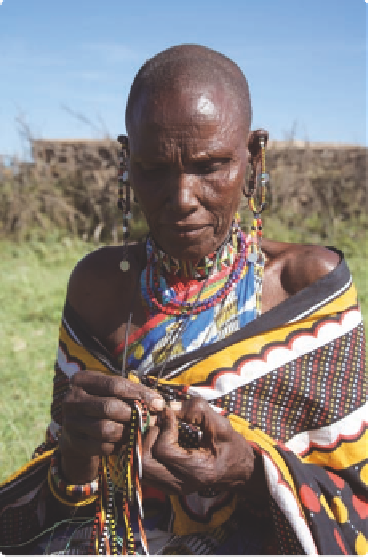Travel Reference
In-Depth Information
now own and run. Each hut has twin wrought-
iron beds plus showers, with breakfast served
in a communal dining hut among breadfruit,
papaya and coffee bushes overlooking the
forested Weruweru gorge down to the river
below.
The villagers will take you along lush forest
trails to some of the local sights, including a
farm where you can see how coffee is processed,
from harvesting the beans to drying them on
parchment, followed by a tasting of the final
product - Bourbon and Kent arabica coffee.
If there's a caffeine-fuelled spring in your
step afterwards you can go on a variety of
guided walks in the area, from strolls along
the Weruweru Valley, where there are several
waterfalls, to long treks to nearby caves once used
by the Chagga to shelter from Maasai raiders.
Mount Kilimanjaro is of course the magnet in
this part of Tanzania, but if you want to pause
for a few days and experience more of the local
culture then come to Kahawa Shamba. You'll
learn about the rural way of life in Tanzania,
perhaps even a bit of Swahili, and, in future,
whenever you smell fresh coffee, you'll be
instantly transported back to this beautiful,
tranquil place. That's a fair trade.
govern your moves.
Over a week spent
living with a Maasai
family in the village
of Olturuto, in the
Kajiado district 30km
from Nairobi, you'll
have plenty of time
to grapple with
bao
's
intricacies. You'll also
become immersed in
other aspects of daily life
of the herders and their
families. Helping with the
chores may not seem like
a holiday, but a few days
grinding maize to make
flour, milking the cows
or collecting water from
the borehole is the best
way to learn what life's really like in an African
village. The reality is that most of your day is
spent not working as we know it, but slowly
passing time - catching up on local gossip,
making arrows, weaving baskets or simply
taking some time to contemplate the vastness of
your surroundings.
Assisted at all times by a translator, you'll also
get the chance to talk with elders and medicine
men and spend two days on a more traditional
tourist activity on safari in nearby Amboseli
National Park, home to elephants, lions and
giraffes. And while the chance to see a lion from
the back of a jeep is what brings most tourists to
Kenya, very few get the chance to experience the
simple rhythms of life as a Maasai.
Crafts being made by a
Maasai in the Maasai Mara
Need to know
Kahawa Shamba is 20km (a 1hr
drive) from Moshi. For prices and reservations visit
W
www.tribes.co.uk;
T
+44 (0) 1728 685 971.
175 lIvE wITH THE MAASAI,
kEnyA
As you sit back on the dusty ground after dinner,
your stomach stretched contentedly after one
too many balls of
irio
- the staple food formed
by mixing green corn with beans, potatoes and
greens - your Maasai host challenges you to a
game of
bao
, said by some to be the oldest board
game in the world. Like many such games, it
appears a simple matter of getting your pieces
from one end to the other - until you start
playing and discover the endless rules that
Need to know
GSE Ecotours organizes
homestays (lasting four to fourteen days) in
five villages in the Great Rift Valley and Central
and Eastern provinces. Prices start from around
KES6200 (US$80) per person per night, which
includes accommodation, meals and ground
transportation from Nairobi. For further enquiries
see
W
www.gse-ecotours.com or
T
+44 (0) 870
766 9891.





















Search WWH ::

Custom Search